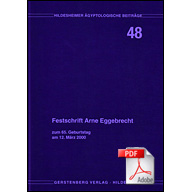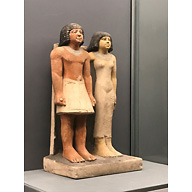-
- Format
- Article
-
- Language
- ENGLISH
-
- Series
- Hildesheimer Ägyptologische Beiträge
-
- Year Published
- 2002
-
- Number of Pages
- 9
-
- Citation Text
- Simpson, William Kelly. "Grammar of Egyptian Statuary: The Old Kingdom." In Bettina Schmitz, ed. Festschrift Arne Eggebrecht zum 65. Geburtstag am 12. März 2000. Hildesheimer Ägyptologische Beiträge 48. Hildesheim: Gerstenberg Verlag, 2002, pp. 107-115.
-
- Individual - Ancient
- Hetepheres II (G 7110-7120)
- Kanefer (G 1203)
- Menkaure
- Meresankh III (G 7530-7540)
- Mersuankh (G 8990)
- Seneb (Seneb)
-
- Author
- William Kelly Simpson, American
-
- Publisher
- Gerstenberg Verlag
-
- Editor
- Bettina Schmitz
-
Fragment of greywacke triad of Menkaure
- MFAB_12.1514
-
Greywacke pair statue of Menkaure and Queen
- MFAB_11.1738
-
Limestone standing pair statue
- KHM_ÄS_7788
-
Reproduction of greywacke pair statue of Menkaure and Queen
- EMC_SR_2/15815
Ancient People
-
- Type Individual - Ancient
- Remarks Original owner of G 7110, along with Kawab (owner of G 7120). Appears with her daughter Meresankh III in G 7530-7540 (east and west walls, main room), and in pair statue MFA 30.1456 (= 27-4-963 + 27-4-964 + 27-4-965). Later married to a king, possibly Djedefre (Radjedef) according to Reisner, but Khafre is also a possibility. Her association with G 7350, and its sarcophagus is uncertain. Also mentioned in tomb of her steward Khemetnu (owner of G 5210).
-
- Type Individual - Ancient
- Remarks Owner of G 1203. Limestone slab stela (Hearst 6-19807) inscribed for Kanefer, identified as [jmj-r wpwt xrp tmAtjw] overseer of commissions, director of bowcase bearers; pieces found in G 1203 chapel and displaced in walls of pit in G 1235 chapel.
-
- Type Individual - Ancient
- Remarks Fifth king of Dynasty 4. Son of Khafre. Husband of Khamerernebti II. Builder of the Third Pyramid at Giza. Known two thousand years later by the Greeks as King Mycerinus.
-
- Type Individual - Ancient
- Remarks Owner of G 7530-7540.Granddaughter of King Khufu, builder of the Great Pyramid, and wife of either Khafre or Menkaure. Her unique underground chapel (labeled G 7530-7540) preserves beautifully carved and painted scenes of the queen and her royal family, as well as servants, artisans, and funerary priests. The scenes also depict the sort of rich burial goods that would have been placed in Meresankh’s tomb: statues and fine furniture; boxes containing food, clothing, and jewelry; even a representation of the black granite sarcophagus that was actually found in situ in her burial chamber. Chapel entrance architrave, jambs, reveals and drum inscribed for Meresankh, idenitifed as [mAAt Hr stX wrt Hts nbwj xt Hr wrt Hst DHwtj smrt Hr mrt=f sAt nswt n Xt=f Hmt nswt mrt] seer of Horus and Seth, great one of the hetes-scepter of the Two Lords, khet-priestess of Horus, great of praises of Thoth, companion of Horus, his beloved, king's daughter of his body, beloved king's wife; in situ in G 7530-7540. Appears in chapel relief of main room: seated holding lotus (south wall); standing with her mother (east wall), idenitifed as [wrt Hts] great one of the hetes-scepter; on pillars (north wall), idenitifed as [tjst Hr] intimate(?) of Horus; seated at offering table, standing north of false door and on central pillar, and with her mother and son (west wall), idenitifed as [Hm-nTr DHwtj wrt Hts nbtj Hm-nTr bApf Hm-nTr HwtHr nbt jwnt smAwt mrjj nbtj] priestess of Thoth, great one of the hetes-scepter of the Two Ladies, priestess of Bapef, priestess of Hathor Mistress-of-Dendera, consort of him who is beloved of the Two Ladies; in situ in G 7530-7540. Also appears on all walls of offering (west) room; in situ in G 7530-7540. Architrave on north wall of north room inscribed for Meresankh; uninscribed statues may also represent Meresankh (along with other female family members); in situ in G 7530-7540. Black granite sarcophagus (Cairo JE 54935) inscribed for Meresankh, idenitifed as [xrp sSmtjw SnDt] director of butchers of the 'Acacia House'; in situ in burial chamber of G 7530-7540. Incomplete limestone statue of Meresankh (MFA 30.1457) and pair statue of Meresankh and Hetepheres II (MFA 30.1456); found displaced in debris of main room. Mother ([mwt=f] his mother) of Nebemakhet (owner of G 8172 = Lepsius 86). Appears in relief of inner chapel (above doorway in eastern wall), identified as [mAAt Hr stX wrt Hts wrt Hst Hmt nswt] seer of Horus and Seth, great one of the hetes-scepter, great of praises, king's wife; in situ in G 8172. Also mentioned in the tomb of her steward Khemetnu (owner of G 5210).
-
- Type Individual - Ancient
- Remarks Owner of G 8990. Chapel lintel, door jambs and reveals inscribed for Mersuankh, identified as [jmj-r jdw n Xnw sHD Hmw-kA nfr] overseer of young men of the Residence, inspector of ka-priests, cadet; in situ in G 8990. False door inscribed for Mersuankh, identified as [Dt smr rawr jmj-r jdw n Xnw jmj-r jSt=f nbt n Xnw nt rwt] djet-priest of the companion Rawer, overseer of young men of the Residence, overseer of all his (Rawer's) possessions of the Residence and the exterior; in situ in G 8990. Four limestone offering tables inscribed for Mersuankh; in situ before false door. Also appears on false door of his mother Rudjsaus, and in wall reliefs and statuary (JE 66617-66620) from serdabs and shafts; in situ in G 8990.
-
- Type Individual - Ancient
- Remarks Owner of Seneb (unnumbered mastaba excavated by Junker). Various architectural elements inscribed for Seneb: lintel and drum lintel of offering room entrance, identified as [wr-a xrp hwwt nt Nt jmj-r mr pr-aA] he who is carried in the sedan chair, director of estates of the Red Crown, overseer of weaving mills of the Great House; south false door (Cairo JE 51297), identified as [xrp dngw sSrw xtmw-nTr n wnHrbAw Hm-nTr wADt nb pr-nw jmj-r jwHw smr pr] director of dwarfs in charge of dressing, god's sealer of the Wenherbau-ship, priest of Wadjet lady of the Lower Egyptian shrine, overseer of libations (?), companion of the house; and granite offering stone, identified as [wr-a smr pr] he who is carried in the sedan chair, companion of the house; all found in situ in mastaba of Seneb. Seated family group statue (Cairo JE 51280) of Seneb (depicted as a dwarf, and identified as [wr-a xrp dngw sSrw smr Hm-nTr xwfw Hm-nTr Ddfra Hm-nTr WADt Hm-nTr kA wr xnt sTpt xrp Hwwt mw Hm-nTr kA mrHw xrp aprw ksw] he who is carried in the sedan chair, director of dwarfs in charge of dressing, companion, priest of Khufu and Djedefre, priest of Wadjet, priest of the Great Bull foremost of Setjpet, director of the estates of water, priest of the Merhu bull, director of crews of the kesu-ships), his wife Senetites, and two children; found in situ in stone box (Cairo JE 51281) in mastaba of Seneb serdab (north of north false door). Base fragment of granite statue (Hildesheim 3132) inscribed for Seneb, identified as [wr-a xrp dngw sSrw Hm-nTr wADt smr xrp hwwt nt Nt] he who is carried in the sedan chair, director of dwarfs in charge of dressing, priest of Wadjet, companion, director of estates of the Red Crown; found in mastaba of Seneb.
Modern People
-
- Type Editor
- Nationality & Dates
- Remarks Curator at the Roemer und Pelizaeus Museum, Hildesheim.
-
- Type Author
- Nationality & Dates American
-
- Type Publisher
- Remarks German publisher in Hildesheim.
Name of this image
Description of the image duis mollis, est non commodo luctus, nisi erat porttitor ligula, eget lacinia odio sem nec elit. Sed posuere consectetur est at lobortis. Donec sed odio dui.

- Heather ONeill heather@pixelsforhumans.com
- Nicholas Picardo npicardo@fas.harvard.edu
- Luke Hollis luke@archimedes.digital


